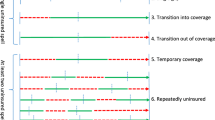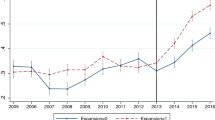Abstract
The Affordable Care Act (ACA) improved welfare by expanding, subsidizing, and standardizing healthcare coverage. At the same time, the law also penalizes the remaining uninsured and establishes a benchmark private policy that charges premiums and cost-sharing expenses in the non-group market. This paper introduces a conceptual and empirical framework for evaluating the net effects of ACA coverage expansions for the individual welfare of previously uninsured adults. Using restricted-access data from the 2010–2012 Medical Expenditure Panel Survey, I evaluate the short-term welfare effect as a function of health and non-medical consumption. I simulate post-ACA insurance status then evaluate the change in expected medical consumption and the utility of consumption by estimating parameter values for a generalized gamma distribution of the ex-ante spread of healthcare and medical spending for each person. The ACA generates a modest net improvement in individual welfare on average (+ $91). While low-income individuals realize gains (+ $539), all other income-groups realize increasingly large losses. The uninsured majority (65%) realize average losses (− $158). Medicaid beneficiaries realize substantial gains (+ $1309). While in most specifications, exchange enrollees realize average gains (+ $146), just under a quarter (24%) realizes any improvement. The chronically-ill realize substantial gains (+ $1065). The non-chronically-ill majority (71%) realize average losses (− $312). Despite weakly lower risk premiums (− $28), medical spending increases in catastrophic scenarios on average. The ACA improves the welfare of some, especially the low-income and chronically-ill. Medicaid generates unequivocal gains for beneficiaries. Most previously uninsured adults remain uninsured, some of whom pay a penalty. The subsidized cost of ACA private insurance outweighs its benefits for most exchange enrollees.



Similar content being viewed by others
Notes
This analysis simulates the law’s effects as initially passed and enforced, which includes a financial penalty for those who remain uninsured. Congress has since eliminated the penalty.
When Handel (2013) divides a large sample into 104 small, finely tuned categories of expected medical spending, each observed distribution of medical expenditures exhibits a prominent right tail. This suggests that each individual faces a skewed distribution of potential medical needs.
For simplicity, I assume that in the short term, a change in insurance status does not prevent health problems nor alter the consumer’s labor productivity or wages.
For example, the generalized gamma was used to estimate inpatient medical expenditures, which are drawn from a heavily skewed distribution, in which most population members will have an observation of $0 but those above $0 tend to be very high (Manning et al. 2005).
See Appendix Table A2 for gamma regression results and variable specifications.
I do not deduct debt from initial endowment because the individual can consume equity in one form, e.g. a home equity line of credit, without necessarily detracting from debt in another, e.g. a credit card. The two don’t necessarily cancel each other out.
For example, if a family holds $150,000 in home equity and their state exempts $100,000 worth of that asset type, they pay $50,000 in home equity. Higher income households pay the maximum amount between the asset- and income-based rules per state and federal regulations.
Reflecting the lower proportion of states expanding Medicaid in this study relative to all states, this figure is slightly higher than the literature consensus on the overall population (60–62%) (Clarke et al. 2017; Garrett and Gangopadhyaya 2016; Uberoi et al. 2016). My estimate of 65% falls between estimates of the number remaining uninsured in expansion states (55%) and non-expansion states (71%); and somewhat closer to the non-expansion states (Garrett and Gangopadhyaya 2016).
Poor health is defined as any prior diagnosis of one of the nine conditions most predictive of medical spending in the population: angina, cancer, coronary heart disease, diabetes, myocardial infarction, poor mental health, any physical limitation, asthma, or emphysema.
I find the expected value of medical claims paid (medical consumption—OOP) for each individual, and deduct half of that value from the original estimate of welfare change.
Medicare X introduced by senators Tim Kaine (CO) and Michael Bennet (VA) https://cdn.americanprogress.org/content/uploads/2018/02/21130514/MedicareExtra-report.pdf.
Choose Medicare Act, introduced by senators Jeff Merkley (OR) and Chris Murphy (CT) https://www.murphy.senate.gov/download/choose-medicare-one-pager.
Medicare for all https://live-berniesanders-com.pantheonsite.io/issues/medicare-for-all/.
E.g. the bill lists a 10% tax on estate value in excess of $500 million or above $1 billion for married couples.
References
Allen, H., Swanson, A., Wang, J., & Gross, T. (2017). Early medicaid expansion associated with reduced payday borrowing in California. Health Affairs (Project Hope),36(10), 1769–1776. https://doi.org/10.1377/hlthaff.2017.0369.
Basseyn, S., Saloner, B., Kenney, G. M., Wissoker, D., Polsky, D., & Rhodes, K. V. (2016). Primary care appointment availability for medicaid patients: Comparing traditional and premium assistance plans. Medical Care,54(9), 878. https://doi.org/10.1097/MLR.0000000000000573.
Blumberg, L. J., & Holahan, J. (2015). After King v. Burwell: Next steps for the Affordable Care Act. Retrieved January 19, 2018, from https://www.urban.org/research/publication/after-king-v-burwell-next-steps-affordable-care-act
Box-Steffensmeier, J. M., & Jones, B. S. (2004). Event history modeling: A guide for social scientists. Cambridge: Cambridge University Press. Retrieved from http://www.loc.gov/catdir/toc/cam041/2003056923.html
Centers for Disease Control and Prevention. (2017, September 15). Preventive Health Care. Retrieved February 9, 2018, from https://www.cdc.gov/healthcommunication/toolstemplates/entertainmented/tips/PreventiveHealth.html
Clarke, T., Norris, T., & Schiller, J. (2017). Early release of selected estimates based on dta from the 2016 National Health Interview Survey. National Center for Health Statistics. Retrieved from https://www.cdc.gov/nchs/fastats/health-insurance.htm
Congressional Budget Office. (2017). CBO’s record of projecting subsidies for health insurance under the Affordable Care Act: 2014 to 2016 (no. 53094). Washington, DC. Retrieved from https://www.cbo.gov/system/files/115th-congress-2017-2018/reports/53094-acaprojections.pdf
Farley, P. J. (1985). Who are the underinsured? The Milbank memorial fund quarterly health and society,63(3), 476–503. https://doi.org/10.2307/3349844.
Finkelstein, A., Hendren, N., & Luttmer, E. F. P. (2015). The value of medicaid: Interpreting results from the Oregon health insurance experiment. National Bureau of Economic Research, working paper series, no. 21308. https://doi.org/10.3386/w21308
Finkelstein, A., Hendren, N., & Shepard, M. (2017). Subsidizing health insurance for low-income adults: Evidence from Massachusetts (working paper no. 23668). National Bureau of Economic Research. https://doi.org/10.3386/w23668
Finkelstein, A., Taubman, S., Wright, B., Bernstein, M., Gruber, J., Newhouse, J. P., et al. (2012). The Oregon health insurance experiment: Evidence from the first year. The Quarterly Journal of Economics,127(3), 1057–1106.
Frean, M., Gruber, J., & Sommers, B. D. (2017). Premium subsidies, the mandate, and Medicaid expansion: Coverage effects of the Affordable Care Act. Journal of Health Economics,53, 72–86. https://doi.org/10.1016/j.jhealeco.2017.02.004.
Gabel, J. R., Whitmore, H., Green, M., Stromberg, S., & Oran, R. (2015, December 21). Consumer cost-sharing in marketplace vs. employer health insurance plans, 2015. Retrieved January 17, 2018, from http://www.commonwealthfund.org/publications/issue-briefs/2015/dec/cost-sharing-marketplace-employer-plans
Garrett, B., & Gangopadhyaya, A. (2016). Who gained health insurance coverage under the ACA, and where do they live? Urban Institute. Retrieved from https://www.urban.org/research/publication/who-gained-health-insurance-coverage-under-aca-and-where-do-they-live
Han, X., Nguyen, B. T., Drope, J., & Jemal, A. (2015). Health-related outcomes among the poor: Medicaid expansion vs. non-expansion states. PLoS ONE,10(12), e0144429. https://doi.org/10.1371/journal.pone.0144429.
Handel, B. R. (2013). Adverse selection and inertia in Health Insurance Markets: When nudging hurts. American Economic Review,103(7), 2643–2682. https://doi.org/10.1257/aer.103.7.2643.
Herring, B. (2005). The effect of the availability of charity care to the uninsured on the demand for private health insurance. Journal of Health Economics,24(2), 225–252. https://doi.org/10.1016/j.jhealeco.2004.08.003.
Hinde, J. M. (2017). Incentive(less)? The effectiveness of tax credits and cost-sharing subsidies in the Affordable Care Act. American Journal of Health Economics,3(3), 346–369. https://doi.org/10.1162/ajhe_a_00078.
Internal Revenue Service. (2016). Health savings accounts and other Tax-Favored Health Plans (No. 969). Department of the Treasury. Retrieved from https://www.irs.gov/pub/irs-prior/p969–2015.pdf
Jacobs, P. D., Hill, S. C., & Abdus, S. (2017). Adults are more likely to become eligible for medicaid during future recessions if their state expanded medicaid. Health Affairs,36(1), 32–39. https://doi.org/10.1377/hlthaff.2016.1076.
Levy, H., & DeLeire, T. (2008). What do people buy when they don’t buy health insurance and what does that say about why they are uninsured? Inquiry,45(4), 365–379.
Long, S. K., & Dimmock, T. H. (2014, November 25). Health insurance coverage and Health Care Access and affordability in Massachusetts: Holding Steady in 2013. Retrieved July 9, 2018, from https://www.urban.org/research/publication/health-insurance-coverage-and-health-care-access-and-affordability-massachusetts-holding-steady-2013
Mahoney, N. (2015). Bankruptcy as implicit health insurance. The American Economic Review,105(2), 710–746. https://doi.org/10.1257/aer.20131408.
Manning, W. G., Basu, A., & Mullahy, J. (2005). Generalized modeling approaches to risk adjustment of skewed outcomes data. Journal of Health Economics,24(3), 465–488. https://doi.org/10.1016/j.jhealeco.2004.09.011.
Meier, S. K. (2016). Examining risk classification strategies for the development of a measure of medical care economic risk in the United States. Journal of Economic and Social Measurement,41(3), 289–305. https://doi.org/10.3233/JEM-160430.
Obama, B. (2016). United states health care reform: Progress to date and next steps. JAMA,316(5), 525–532. https://doi.org/10.1001/jama.2016.9797.
Pauly, M., Leive, A., & Harrington, S. (2018). Losses (and gains) from health reform for non-medicaid uninsureds. Journal of Risk and Insurance. https://doi.org/10.1111/jori.12255.
Pearson, C. F. (2015, March 25). Exchanges struggle to enroll consumers as income increases. Retrieved November 27, 2017, from http://avalere.com/expertise/managed-care/insights/exchanges-struggle-to-enroll-consumers-as-income-increases
Polyakova, M., Hua, L. M., & Bundorf, M. K. (2017). Marketplace plans provide risk protection, but actuarial values overstate realized coverage for most enrollees. Health Affairs,36(12), 2078–2084. https://doi.org/10.1377/hlthaff.2017.0660.
Shi, L., Feng, C., Griffin, S., Williams, J. E., Crandall, L. A., & Truong, K. (2017). Does awareness of the Affordable Care Act reduce adverse selection? A study of the long-term uninsured in South Carolina. INQUIRY: The Journal of Health Care Organization, Provision, and Financing, 54, 0046958017727103. https://doi.org/10.1177/0046958017727103
Sommers, B. D., Baicker, K., & Epstein, A. M. (2012). Mortality and access to care among adults after state medicaid expansions. New England Journal of Medicine,367(11), 1025–1034. https://doi.org/10.1056/NEJMsa1202099.
Sommers, B., Kronick, R., Finegold, K., Po, R., Schwartz, K., & Glied, S. (2015). Understanding participation rates in medicaid: Implications for the Affordable Care Act. Retrieved from https://aspe.hhs.gov/basic-report/understanding-participation-rates-medicaid-implications-affordable-care-act
Thorpe, K. E., Allen, L., & Joski, P. (2015). Out-of-pocket prescription costs under a typical silver plan are twice as high as they are in the average employer plan. Health Affairs,34(10), 1695–1703. https://doi.org/10.1377/hlthaff.2015.0323.
Uberoi, N., Finegold, K., & Gee, E. (2016). Health insurance coverage and the Affordable Care Act, 2010–2016 (issue brief). ASPE. Retrieved from https://aspe.hhs.gov/pdf-report/health-insurance-coverage-and-affordable-care-act-2010-2016
Author information
Authors and Affiliations
Corresponding author
Additional information
Publisher's Note
Springer Nature remains neutral with regard to jurisdictional claims in published maps and institutional affiliations.
Electronic supplementary material
Below is the link to the electronic supplementary material.
Rights and permissions
About this article
Cite this article
Zewde, N. The individual welfare effects of the Affordable Care Act for previously uninsured adults. Int J Health Econ Manag. 20, 121–143 (2020). https://doi.org/10.1007/s10754-019-09273-y
Received:
Accepted:
Published:
Issue Date:
DOI: https://doi.org/10.1007/s10754-019-09273-y




